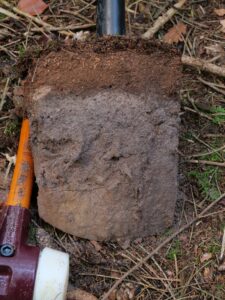The subtype Typical Moder is characterised by a diffuse transition between Ol, Of, and Oh horizons. The degree of cross-linking of plant residues increases from the top downwards, especially in coniferous stands, and the Of material can be slightly felted or layer-like. Within the Of horizon, the proportion of fine organic matter increases with increasing depth. The packing of the Oh is powdery to friable (resembling coffee grounds) and disintegrates easily into slightly rounded aggregates (Obh). Easily breakable Oh horizons that disintegrate to powder or crumble easily under a slight pressure from the thumb on the coarse aggregates are considered Obh horizons. The Obh may contain interstratified, less decomposable plant residues. The well-rounded aggregates resulting from the disintegration of Obh material can contain needle fragments and arthropod droppings that are embedded randomly in the macroscopically amorphous fine organic matter via biological mixing. The Obh horizon is often strongly penetrated by roots. The transition between the Obh horizon and the mineral soil is diffuse. The Ah horizon is usually < 10 cm thick. Depending on the thickness of the Obh horizon, Typical Moder is subdivided into the varieties Typical Moder poor in fine organic matter (Obh horizon < 2 cm) and Typical Moder rich in fine organic matter (Obh horizon ≥ 2 cm). The variety which is rich in fine organic matter is characterised by higher CN ratios. Distinct features are:
-
Ol horizon and Olf horizon are present all year round;
-
Ohf horizon is present all year round, usually rooted;
-
Obh horizon is present;
-
indistinct transitions between O horizons; and
-
occurrence of a thin Ah horizon or Ee-Ah horizon or Ah-Ee horizon.
Typical Moder with needles from Norway spruce (Picea abies), showing Ol, Olf, Ohf, Obh, and Ee-Ah horizon. Transitions between O horizons are indistinct (Photo: Alexander Konopatzky).

